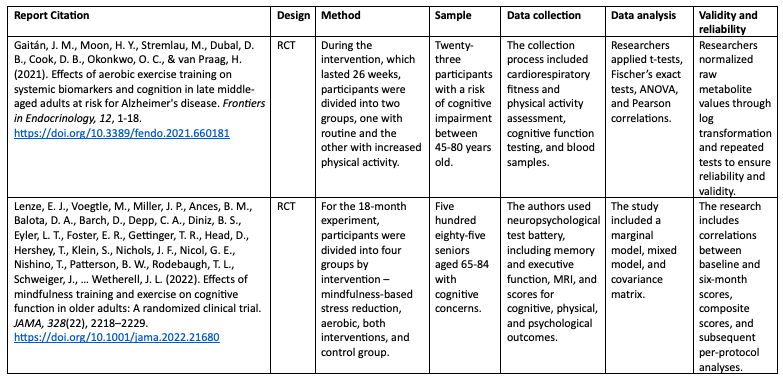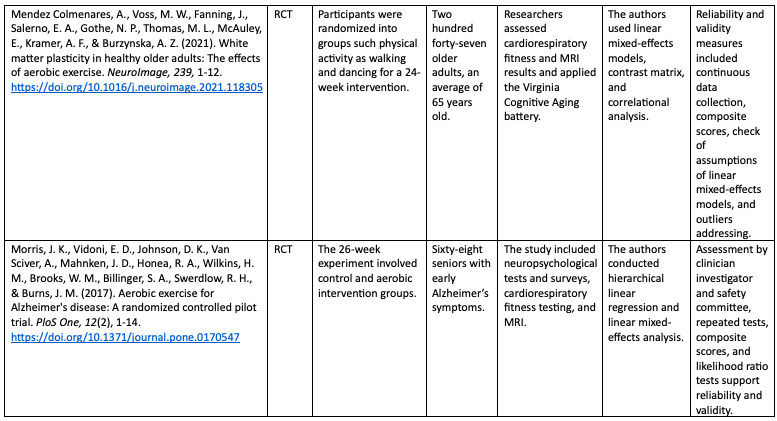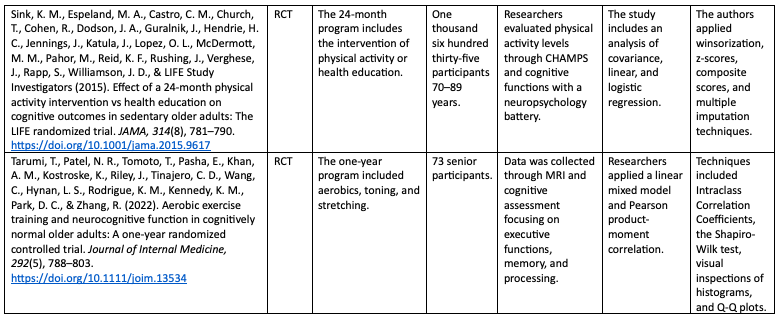Abstract
The current integrative review focuses on the impact of exercise intervention on the cognitive functions of dementia patients. It includes a research question, “In older adults with a diagnosis of cognitive impairment or dementia (P), how do exercise interventions (I), as compared to no exercise interventions (C), affect their cognitive function (O)?”. Six publications describing randomized control trials that investigated similar problems were evaluated. The review included carefully selected sources and explored the research process, methodology, results, and limitations. Most of the publications reviewed do not support the assumption about a positive effect of physical activity on cognitive performance but indicate ambiguity in their results, calling for more research.
Introduction
This integrative review aims to investigate the effects of exercise intervention compared to no intervention on the cognitive functions of older adults diagnosed with cognitive impairment or dementia. The purpose is to validate an Exercise Intervention program for Sacramento Community Hospital. The paper’s objective is to examine scholarly literature using a systematic approach for current analysis and synthesize six high levels of evidence (LOE) research articles. The topic chosen is the focus of the review, as understanding the possibilities of managing and slowing cognitive deterioration is essential for effective treatment planning and improving dementia patients’ quality of life.
The research is directed by the following PICO question, “In older adults with a diagnosis of cognitive impairment or dementia (P), how do exercise interventions (I), as compared to no exercise interventions (C), affect their cognitive function (O)?” Evidence shows that physical activity positively affects brain functioning (Lenze et al., 2022). Consequently, it is possible to build a hypothesis that exercise will also be able to slow down the deterioration of cognitive performance in patients with dementia. Based on the research question, the review focuses on specific variables – intervention involving exercise is an independent variable, and change in cognitive function is a dependent one.
Considering the topic’s background, cognitive impairment in older dementia patients is a widely discussed issue. However, no suitable treatment is available, and alternative interventions must be sought (Gaitán et al., 2021). Organizing interventions requires establishing appropriate policies and procedures, cooperation between specialists, investment of resources, and solving other administrative issues. Healthcare administrators are responsible for these processes and, therefore, need to be aware of the potential effectiveness of their measures. They should analyze and interpret evidence from research to support decision-making and know what actions will justify the efforts (“Health Administration,” n.d.). As a result, conducting a review is significant for the practice of health administrators.
Literature Search
The review includes six publications carefully selected when searching for literature. Keywords and combinations included phrases for each part of the PICO question. Combinations using Boolean operators were most effective, as they allowed the inclusion of synonyms for terms. Thus, the query “Older adults OR Geriatric patients) AND (Dementia OR Cognitive impulse) AND (Physical activity OR Exercise) AND (Cognitive function OR Cognitive performance)” brought more results.
The search was done in three databases – Google Scholar, PubMed, and Cochrane Systematic Reviews base. They were chosen due to such characteristics as ease of use of filters, connections with other databases, and many sources in the public domain. PubMed produced more results thanks to its focus on medical research. Moreover, the database provided transparent information about articles, supporting the website’s reliability and allowing trustworthy publications to be selected.
The review applied inclusion and exclusion criteria to select the most suitable and reliable evidence. The chosen studies were published in peer-reviewed journals over the past ten years to ensure the evidence is up-to-date and verified. During the study process of publications, research conducted outside the United States was excluded to fit the context of the healthcare system better. Moreover, the article’s structure and the authors’ background were evaluated to confirm credibility and determine the final sample.
Methodology Analysis
Methodology
The review explored studies focused on the effects of exercise on various aspects of cognitive functioning. All authors chose randomized controlled trials (RCTs) as the design, which represents II LOE. This approach is appropriate for answering research questions and testing hypotheses. RCTs help establish causal relationships between variables, and such characteristics as control and randomization support the reliability of the evidence (Sharma et al., 2020). Sink et al.’s (2015) research stands out among the publications analyzed, as it has the most considerable number of participants and the duration of observations. Consequently, other studies could be improved by including more participants and extending the experiment time.
Statistical Data Analyses
The explored studies applied such statistical methods as mixed-effects models, t-tests, ANOVA, and regression analyses. They are aimed at determining the effect of one variable on another and, therefore, are suitable for addressing the research inquiries in the studies. The choice of such an approach to analysis is consistent with the research methodology, as they aim to specify the impact of exercise intervention in the spotlight.
Gaps
The articles analyzed are not devoid of problems and gaps. For example, only two studies by Lenze et al. (2022) and Tarumi et al. (2022) drew attention to confounding aspects, which may affect the results. Although all studies were in the US with diverse populations, only Sink et al. (2015) and Lenze et al. (2022) pointed to the diversity of their sample. Such a gap can affect the potential for generalization of findings. Finally, the researchers studied only a few cognitive functions, which may have led to missing the whole picture. However, conducting RCTs requires mobilizing significant resources, and therefore, the researchers had to choose between the desired approach and the available opportunities.
Inconsistencies
Examined publications argue about the importance of their findings in dementia management. However, participants in most RCTs had no cognitive impairment, except for Morris et al. (2017), who included patients with early Alzheimer’s. Studies by Gaitán et al. (2021), Lenze et al. (2022), and Sink et al. (2015) included participants at risk of dementia or mild concerns, and the rest included healthy patients. This sampling approach is chosen because of the complexity of involving dementia patients in long-term research.
Synthesis and Interpretation



Note. The table represents some characteristics of the analyzed papers (Created by the author).
Comparing and Contrasting
The conclusions of the explored articles were divided into contrasting opinions. Tarumi et al. (2022) most confidently declared an improvement in participants’ cognitive performance. Gaitán et al. (2021) found a positive impact on biomarkers associated with cognitive function and suggested the possibility of a neuroprotective effect. Mendez Colmenares et al. (2021) stated that dance exercises can preserve the plasticity of white matter. However, Lenze et al. (2022), Morris et al. (2017), and Sink et al. (2015) found no significant effect of the interventions. All authors point to limitations and a lack of accuracy in their results, calling for further research.
Research Strategies
The selected research strategies in the articles are valuable for creating healthcare programs. The selected RCT design aims to assess the effectiveness of the intervention and answers the question of its effect on the chosen variable. Moreover, the analysis methods used by the authors also investigate the correlation between variables of interest. The investigation of the required intervention and its effect provides data for the implementation of programs, including selecting the most effective measures, allocating resources, and involving personnel.
Ethical Issues
Conducting research requires following appropriate existing ethical regulations. Ethics is necessary to achieve research goals, such as organizing cooperation between specialists for an experiment, finding the truth to answer research questions accurately, and similar aspects (Resnik, 2020). Therefore, failure to meet standards limits opportunities to support study reliability and trustworthiness.
In health research, clinical ethical standards of human respect, autonomy, justice, beneficence, and nonmaleficence are critical (Jacobsen, 2021). These norms guide the research process and influence the choice of methods. For instance, the informed consent procedure provided for under the autonomy principle helps to ensure that all participants understand the features of the study and voluntarily participate. In this way, trust and cooperation between participants and researchers is established.
Patterns and Trends
The criteria for inclusion and exclusion in choosing studies contributed to similar patterns. Although they include a variety of interventions such as aerobics, dancing, or stretching, they all explore physical activity and its effects on cognitive function. Researchers also chose a similar methodology, focusing on long-term observations, six months to two years, to identify the impact. Moreover, notable patterns were the need to assess cognitive performance through neuropsychological tests and the use of MRI to determine brain changes.
Finally, the results of the studies are divided: half of the articles show a possible positive effect, and half show its absence. By generalizing such patterns and trends, one may note that researchers use a holistic experimental approach to understand the interventions’ effect, which is an appropriate option when assessing the potential of a health program. Considering research findings, new studies are needed to test the impact, but the evidence of no effect is more convincing.
Secondary Data
The sources selected for the review are primary research and provide LOE II Level. However, all authors have studied a variety of sources in preparation for their experiments, as reflected in their papers. They used secondary data to check the background of the problem and lay the foundation for their research. Such data help present hypotheses for the study, select eligible participants, and compare the results with other data sources.
Synthesizing
All studies considered in the review were intended to identify the effect of exercise on the cognitive functioning of older patients. The idea of the positive impact of physical activity on the brain has been widely discussed and supported by several studies (Morris et al., 2017). Consequently, hypotheses in the studies also suggested a positive effect and the possibility of slowing cognitive deterioration in older patients.
However, by synthesizing all the findings, one may note that the uncertainty of the intervention effect is common to most of the publications reviewed. The study by Tarumi et al. (2022) claimed improved cognitive performance, but others showed no such confidence. Gaitán et al. (2021) and Mendez Colmenares et al. (2021) also argue that there are improvements in biomarkers and white matter associated with cognitive impairment. However, they also indicate a need for caution in interpreting the results.
Other studies found no effect of exercise intervention; their proof is also substantial. For instance, given that Sink et al. (2015) covered the largest scale in time and number of participants, the study’s evidence is impressive. Research contributes to the body of knowledge as it considers various aspects of cognitive functions, which allows for the evaluation of more details in the complex functioning of the brain. Moreover, they may push new research to study those questions and problems that may have been missed.
Utilizing
The studies examined provide primary data through the design chosen, and the use of secondary information could not be a relevant alternative to this approach. The use of secondary data is necessary when preparing for research and studying the context of the problem. This method preserves the resources and time of the researchers, as it does not include the involvement of participants and the organization of the experiment.
However, such information may differ in quality, and researchers must be careful to answer their questions precisely. Potential reliable sources for search are databases, previous studies, survey results, government records, and similar options. Moreover, when using data from other specialists, the researchers do not have the necessary control and have a limited choice of variables.
Ethical Concerns
The studies examined sought to meet ethical requirements – they were approved by review boards, took informed consent from participants, and their sponsors should not lead to bias. Lenze et al. (2022) did not specify the funding source and potential conflicts of interest but received approval from the institutional review board. Morris et al. (2017) did not include a statement of no conflict of interest and listed several funding sources, such as the Foundation for Physical Therapy and the National Institute of Health. Sink et al. (2015) also received support and sponsorship from the National Institute of Health and several other sources. The rest of the studies included statements about the absence of conflict and verification by review boards.
Conclusion
Strengths
The selected sources have significant strengths as exclusion and inclusion criteria have been applied for selection. In particular, the RCT design provides reliable evidence when the relationship between variables needs to be determined (Sharma et al., 2020). Moreover, the articles have a pattern of using many methods to collect and analyze data, which also supports the quality of evidence and attention to detail. The choice of analysis methods is consistent with the overall methodology in all studies, contributing to consistency. Thus, publications in the review have strengths that support their trustworthiness.
Limitations
Despite the robust methodology, studies have limitations, which complicate the application of results in practice. For example, most articles involved predominantly healthy participants, and therefore, the results may not be sufficiently in the interests of patients with cognitive impairment. Moreover, Lenze et al. (2022) and Sink et al. (2015) noted different patient ethnicities, while other studies included predominantly Caucasians, hindering the generalization of outcomes. These limitations and the authors’ calls for caution in interpreting the results suggest the need for further research.
Findings
Although the results and findings in the published studies differ, the authors made substantial efforts to ensure their reliability and validity. First and foremost, the methodology and approach to data collection and analysis in each study support the quality of evidence. The authors included measures to improve the data quality during the analysis and repeated their tests several times. The researchers accurately selected measurements for their goals, and their results are valuable for practical application. Moreover, all articles accurately and transparently describe the process of their experiments, allowing others to assess their validity and reliability.
Implications
Thus, the study of the impact of activity targeting the cognitive abilities of elderly patients has significant implications for the healthcare academy and practice. Mental deterioration due to dementia is a significant problem for patients, interfering with their quality of life. However, healthcare at the moment cannot offer a suitable solution to the problem, and therefore, it is important to continue searching for it. Even though the studies did not confirm the possibility of improving cognitive performance, they tested the potential intervention. The results can be used for other studies and in practice in creating preventive programs, allocating resources, and managing the patient’s condition. As a result, research helps to develop health care and improve the methods used in it.
References
Gaitán, J. M., Moon, H. Y., Stremlau, M., Dubal, D. B., Cook, D. B., Okonkwo, O. C., & van Praag, H. (2021). Effects of aerobic exercise training on systemic biomarkers and cognition in late middle-aged adults at risk for Alzheimer’s disease. Frontiers in Endocrinology, 12, 1-18. Web.
Health administration careers with universities and research institutes. (n.d.). Healthcare Administration Edu. Web.
Jacobsen, K. H. (2021). Introduction to health research methods: A practical guide (3rd ed.). Jones & Bartlett Learning.
Lenze, E. J., Voegtle, M., Miller, J. P., Ances, B. M., Balota, D. A., Barch, D., Depp, C. A., Diniz, B. S., Eyler, L. T., Foster, E. R., Gettinger, T. R., Head, D., Hershey, T., Klein, S., Nichols, J. F., Nicol, G. E., Nishino, T., Patterson, B. W., Rodebaugh, T. L., Schweiger, J., … Wetherell, J. L. (2022). Effects of mindfulness training and exercise on cognitive function in older adults: A randomized clinical trial. JAMA, 328(22), 2218–2229. Web.
Mendez Colmenares, A., Voss, M. W., Fanning, J., Salerno, E. A., Gothe, N. P., Thomas, M. L., McAuley, E., Kramer, A. F., & Burzynska, A. Z. (2021). White matter plasticity in healthy older adults: The effects of aerobic exercise. NeuroImage, 239, 1-12. Web.
Morris, J. K., Vidoni, E. D., Johnson, D. K., Van Sciver, A., Mahnken, J. D., Honea, R. A., Wilkins, H. M., Brooks, W. M., Billinger, S. A., Swerdlow, R. H., & Burns, J. M. (2017). Aerobic exercise for Alzheimer’s disease: A randomized controlled pilot trial. PloS One, 12(2), 1-14. Web.
Resnik, D. B. (2020). What is ethics in research & why is it important? National Institute of Environmental Health Sciences. Web.
Sharma, N., Srivastav, A. K., & Samuel, A. J. (2020). Randomized clinical trial: Gold standard of experimental designs-importance, advantages, disadvantages and prejudices. Revista Pesquisa em Fisioterapia, 10(3), 512-519. Web.
Sink, K. M., Espeland, M. A., Castro, C. M., Church, T., Cohen, R., Dodson, J. A., Guralnik, J., Hendrie, H. C., Jennings, J., Katula, J., Lopez, O. L., McDermott, M. M., Pahor, M., Reid, K. F., Rushing, J., Verghese, J., Rapp, S., Williamson, J. D., & LIFE Study Investigators (2015). Effect of a 24-month physical activity intervention vs health education on cognitive outcomes in sedentary older adults: The LIFE randomized trial. JAMA, 314(8), 781–790. Web.
Tarumi, T., Patel, N. R., Tomoto, T., Pasha, E., Khan, A. M., Kostroske, K., Riley, J., Tinajero, C. D., Wang, C., Hynan, L. S., Rodrigue, K. M., Kennedy, K. M., Park, D. C., & Zhang, R. (2022). Aerobic exercise training and neurocognitive function in cognitively normal older adults: A one-year randomized controlled trial. Journal of Internal Medicine, 292(5), 788–803. Web.